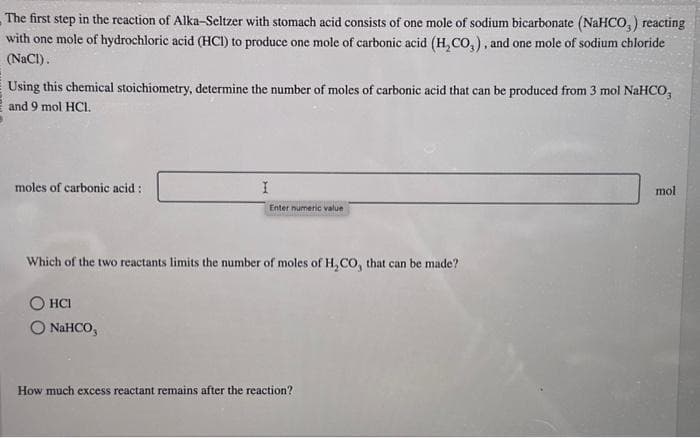The first step in the reaction of Alka-Seltzer with stomach acid consists of one mole of sodium bicarbonate (NaHCO,) reacting with one mole of hydrochloric acid (HCI) to produce one mole of carbonic acid (H₂CO,), and one mole of sodium chloride (NaCl). Using this chemical stoichiometry, determine the number of moles of carbonic acid that can be produced from 3 mol NaHCO, and 9 mol HCl. moles of carbonic acid: I HCI Q NaHCO, Enter numeric value Which of the two reactants limits the number of moles of H₂CO, that can be made? How much excess reactant remains after the reaction? mol
The first step in the reaction of Alka-Seltzer with stomach acid consists of one mole of sodium bicarbonate (NaHCO,) reacting with one mole of hydrochloric acid (HCI) to produce one mole of carbonic acid (H₂CO,), and one mole of sodium chloride (NaCl). Using this chemical stoichiometry, determine the number of moles of carbonic acid that can be produced from 3 mol NaHCO, and 9 mol HCl. moles of carbonic acid: I HCI Q NaHCO, Enter numeric value Which of the two reactants limits the number of moles of H₂CO, that can be made? How much excess reactant remains after the reaction? mol
Introductory Chemistry: A Foundation
9th Edition
ISBN:9781337399425
Author:Steven S. Zumdahl, Donald J. DeCoste
Publisher:Steven S. Zumdahl, Donald J. DeCoste
Chapter9: Chemical Quantities
Section: Chapter Questions
Problem 20CR: Solid calcium carbide (CaC2)reacts with liquid water to produce acetylene gas (C2H2)and aqueous...
Related questions
Question
100%
Che

Transcribed Image Text:The first step in the reaction of Alka-Seltzer with stomach acid consists of one mole of sodium bicarbonate (NaHCO,) reacting
with one mole of hydrochloric acid (HCI) to produce one mole of carbonic acid (H₂CO,), and one mole of sodium chloride
(NaCl).
Using this chemical stoichiometry, determine the number of moles of carbonic acid that can be produced from 3 mol NaHCO,
and 9 mol HCl.
moles of carbonic acid:
I
HCI
Q NaHCO,
Enter numeric value
Which of the two reactants limits the number of moles of H₂CO, that can be made?
How much excess reactant remains after the reaction?
mol
Expert Solution
This question has been solved!
Explore an expertly crafted, step-by-step solution for a thorough understanding of key concepts.
This is a popular solution!
Trending now
This is a popular solution!
Step by step
Solved in 3 steps with 3 images

Knowledge Booster
Learn more about
Need a deep-dive on the concept behind this application? Look no further. Learn more about this topic, chemistry and related others by exploring similar questions and additional content below.Recommended textbooks for you

Introductory Chemistry: A Foundation
Chemistry
ISBN:
9781337399425
Author:
Steven S. Zumdahl, Donald J. DeCoste
Publisher:
Cengage Learning

Chemistry: Matter and Change
Chemistry
ISBN:
9780078746376
Author:
Dinah Zike, Laurel Dingrando, Nicholas Hainen, Cheryl Wistrom
Publisher:
Glencoe/McGraw-Hill School Pub Co

Chemistry & Chemical Reactivity
Chemistry
ISBN:
9781337399074
Author:
John C. Kotz, Paul M. Treichel, John Townsend, David Treichel
Publisher:
Cengage Learning

Introductory Chemistry: A Foundation
Chemistry
ISBN:
9781337399425
Author:
Steven S. Zumdahl, Donald J. DeCoste
Publisher:
Cengage Learning

Chemistry: Matter and Change
Chemistry
ISBN:
9780078746376
Author:
Dinah Zike, Laurel Dingrando, Nicholas Hainen, Cheryl Wistrom
Publisher:
Glencoe/McGraw-Hill School Pub Co

Chemistry & Chemical Reactivity
Chemistry
ISBN:
9781337399074
Author:
John C. Kotz, Paul M. Treichel, John Townsend, David Treichel
Publisher:
Cengage Learning

Chemistry & Chemical Reactivity
Chemistry
ISBN:
9781133949640
Author:
John C. Kotz, Paul M. Treichel, John Townsend, David Treichel
Publisher:
Cengage Learning

World of Chemistry, 3rd edition
Chemistry
ISBN:
9781133109655
Author:
Steven S. Zumdahl, Susan L. Zumdahl, Donald J. DeCoste
Publisher:
Brooks / Cole / Cengage Learning

Living By Chemistry: First Edition Textbook
Chemistry
ISBN:
9781559539418
Author:
Angelica Stacy
Publisher:
MAC HIGHER